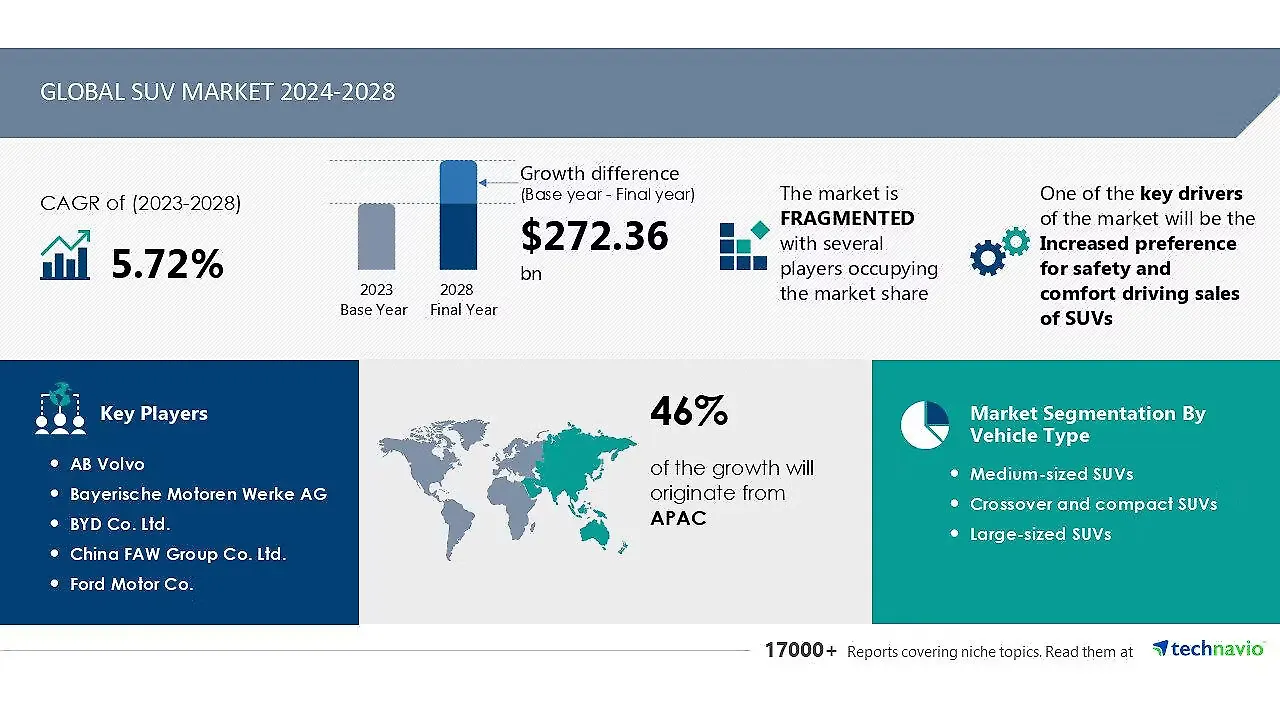
Driven by the Asia-Pacific (APAC), especially from markets like China, Japan, India, and South Korea, the global SUV market is poised for significant growth, with an estimated increase of $ 272.36 billion from 2024 to 2028.
According to Technavio, the market is projected to grow at a compound annual growth rate (CAGR) of 5.72% during this period and the APAC region is expected to be a major contributor, accounting for approximately 46% of this growth.
The APAC region is experiencing substantial growth in the premium SUV and sedan segments, primarily driven by advanced comfort and automatic safety features. Countries like China, Japan, India, and South Korea are seeing high demand for compact and full-size SUVs. The versatility of these vehicles, coupled with multiple drivetrain options and off-roading capabilities, makes them popular in these markets. Additionally, the region's focus on cost-efficiency has heightened interest in fuel-efficient and electric/hybrid SUVs.
European Market
The European market is heavily influenced by stringent emission norms and greenhouse gas (GHG) emissions regulations enforced by the European Commission. These regulations are accelerating the shift towards electric SUVs, with significant contributions from automotive OEMs like Chevrolet and Hyundai. The European market also places a premium on fuel economy and CO2 emissions, with mid-size SUVs being particularly important due to their balance of performance and efficiency.
Mid-Size SUVs
Mid-size SUVs represent a significant and fast-growing segment in the global SUV market. These vehicles offer a combination of advanced features, superior performance, and high seating capacity, catering to both cost-conscious consumers and those seeking luxury. Popular models in this segment include:
Manufacturers are focusing on fuel efficiency using technologies like turbochargers and updated electronic systems. This segment appeals to passengers seeking multi-terrain drivability and sedan-like features, with Europe and APAC being key growth drivers.
The SUV market is continuously evolving with advancements in comfort, safety, and connectivity features. Key technological trends include semi-autonomous and autonomous vehicles, electrification and fuel efficiency.

Challenges & Opportunities
The SUV market faces several challenges, including:
Cost-Sensitivity: The high cost of electric and hybrid vehicles can be a barrier to adoption in cost-sensitive regions.
Technological Advancements: Keeping pace with rapid technological changes and consumer expectations for advanced features can be challenging.
Competition: Increasing competition from more affordable models and technological advancements in commuter vehicles pose threats to market share.
However, these challenges also present opportunities for growth such as:
Government Incentives: Government incentives for electric vehicles are expected to boost market growth, particularly in APAC.
Innovation in Design and Manufacturing: Continuous innovation in SUV technology and design can help manufacturers stay competitive.
Growing Demand for Larger Vehicles: Increasing disposable income and urbanisation are driving demand for larger, more versatile vehicles.
The global SUV market is set for robust growth, driven by advancements in technology, regulatory pressures for emissions reductions, and changing consumer preferences. The APAC region, with its significant contribution, will play a crucial role in this expansion. As manufacturers continue to innovate and adapt to market demands, the SUV market is expected to see sustained growth, offering diverse options for consumers and addressing key challenges through technological advancements and strategic initiatives.
Courtesy Technavio. Featured photo is representational.
Also Read: